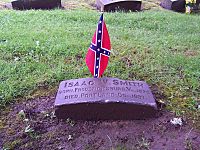Isaac W. Smith (surveyor) facts for kids
Quick facts for kids
Isaac W. Smith
|
|
|---|---|

photographed c. 1890
|
|
| Born |
Isaac Williams Smith
February 15, 1826 Fredericksburg, Virginia, U.S.
|
| Died | January 1, 1897 (aged 70) Portland, Oregon, U.S.
|
| Resting place | River View Cemetery, Portland, Oregon |
| Nationality | American |
| Military career | |
| Allegiance | |
| Service/ |
United States Army |
| Years of service | 1847–1848 1861–1865 |
| Rank | |
| Unit | Voltigeur Regiment Corps of Engineers |
| Battles/wars | Mexican-American War American Civil War |
Isaac W. Smith (born Isaac Williams Smith; February 15, 1826 – January 1, 1897) was an American surveyor and civil engineer. A surveyor measures land, and a civil engineer designs and builds things like roads and bridges. He also served as an engineer officer in the Confederate States Army during the American Civil War.
Contents
Early Life and Education
Isaac Smith was born on February 15, 1826, in Fredericksburg, Virginia. He went to the Virginia Military Institute (VMI) and graduated in 1846. One of his teachers was Thomas "Stonewall Jackson", who later became a famous general. After college, Smith worked as an assistant surveyor on many projects. This included helping to map the border between the United States and Canada.
Serving in the Mexican-American War
In 1847, Smith joined the U.S. Army as a Second Lieutenant. He was part of the Regiment of Voltigeurs. He fought in the Mexican–American War at Veracruz. This was an important battle where U.S. forces captured the city.
Early Engineering Work
After the war, Smith returned to his work as a surveyor. He helped map the land between different Native American nations, like the Creek and Cherokee. He also worked on building the Orange and Alexandria Railroad in Virginia.
In 1854, Smith helped survey routes for a possible transcontinental railway across the United States. This railway would connect the East and West coasts.
Building Lighthouses and Surveying Washington
Smith moved to Washington Territory in 1855. There, he oversaw the building of several lighthouses along the Pacific coast and the Strait of Juan de Fuca. He said this work was very difficult and dangerous. He often traveled in small rowboats or Native American canoes. The waters were tricky, and sometimes his crew was only Native Americans.
In 1859, Smith surveyed the Puget Sound Guide Meridian. This was an important line that helped map the land from Seattle almost to the Canadian border. He later became a chief registrar for the General Land Office in Seattle. He also worked as an assistant to Governor Isaac Stevens.
Role in the American Civil War
When the American Civil War began, Smith had to leave his home state of Virginia. He had strong feelings for the South. He went to British Columbia for a short time. In 1862, he returned to Virginia.
Smith joined the Confederate States Army. He became a Captain in the Engineer Corps. He was in charge of the Confederate pontoon service, which built temporary bridges. He played a key role in defending Petersburg and Richmond during the Siege of Petersburg. He was present when the Confederate forces surrendered at Appomattox Court House. After the war, he returned home with just his old uniform, a horse, and a lot of experience.
Later Career and Achievements
After the Civil War, Smith went to Mexico. He worked as an engineer on the Imperial Mexican Railroad. He returned to the Pacific Coast in 1869. He worked on various railroad surveys in California, Oregon, and Washington.
In 1871–72, he built canals and locks around Willamette Falls in Oregon City. These helped boats pass around the falls. He also designed gas and water lines for the city of Tacoma, Washington in 1873.
Smith later surveyed the Fraser River in British Columbia. He wanted to see if steamships could travel on it. He also worked for the State of California on railroad and harbor projects.
Mapping the Cascade Range
Smith returned to Washington to work for the Northern Pacific Railroad. He was in charge of finding the best route for the railroad through the Cascade Range. The route they chose, called "Stampede Pass", was one that Smith had surveyed and mapped.
Father of Portland's Water System
From 1885 to 1897, Isaac Smith was the Chief Engineer for the City of Portland, Oregon, Water Works. In 1886, he led a survey to find a new water source for Portland. He designed and supervised the building of a 24-mile (39 km) pipeline. This pipeline brought water from the Bull Run Reservoir to Portland. The city still gets its drinking water from this source today!
The survey team had to work through a "rugged wilderness" that was mostly unknown. There were no trails, only those made by animals. There were no signs of people or towns anywhere.
Death and Legacy
Isaac Smith was very dedicated to his work. He became sick with pneumonia on Christmas Day in 1896. He died in Portland on January 1, 1897. He never married.
His obituary in The Oregonian newspaper praised his strong sense of duty and honesty. It said he was "one of nature's noblemen" and a man with a "lofty nature." He is buried in a simple grave in River View Cemetery in Portland.
Today, a group called the Sons of Confederate Veterans has a camp in Portland named after him.


